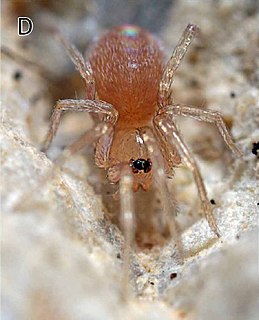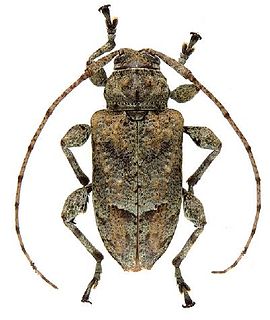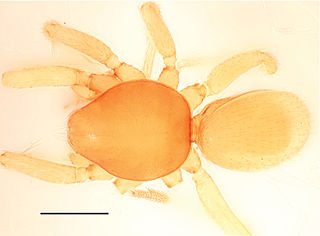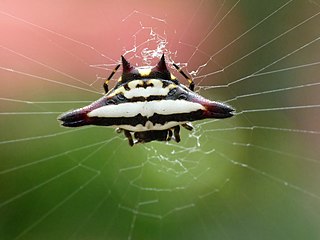
Oonopidae, also known as goblin spiders, is a family of spiders consisting of over 1,600 described species in about 113 genera worldwide, with total species diversity estimated at 2000 to 2500 species. The type genus of the family is OonopsKeyserling, 1835.
Napoca insignis is a species of the jumping spiders found in Israel.

Onomastus is a genus of Asian jumping spiders that was first described by Eugène Louis Simon in 1900. It is the only genus in the subfamily Onomastinae.

Curetis bulis, the bright sunbeam, is a species of butterfly belonging to the lycaenid family. It is found in Asia.

Insect morphology is the study and description of the physical form of insects. The terminology used to describe insects is similar to that used for other arthropods due to their shared evolutionary history. Three physical features separate insects from other arthropods: they have a body divided into three regions, have three pairs of legs, and mouthparts located outside of the head capsule. It is this position of the mouthparts which divides them from their closest relatives, the non-insect hexapods, which includes Protura, Diplura, and Collembola.
Rakiura is a genus of Trichoptera (caddisfly). The genus contains only one species, R. vernale, which is endemic to New Zealand. Rakiura vernale represent the most basal taxon within the Helicopsychidae.

Leptostylopsis annulipes is a species of longhorn beetles of the subfamily Lamiinae.
This glossary describes the terms used in formal descriptions of spiders; where applicable these terms are used in describing other arachnids.

Cebrionini is a tribe of click beetles from the family Elateridae; formerly ranked as a subfamily or family, they are now considered a tribe within the subfamily Elaterinae.

Triaeris stenaspis is a species of spider in the family Oonopidae, with a pantropical distribution. It is also found in Iran and has been introduced into Europe. A very small spider, with a maximum body length of under 2 mm (0.08 in), it has been shown to prey successfully on springtails. Only females have ever been found, and the species may be parthenogenetic, being able to produce female offspring from unfertilized eggs.
Predatoroonops is a genus of goblin spiders endemic to the Brazilian Atlantic Forest. The genus is characterized by the extremely modified male chelicerae and long pairs of ventral spines. It is the first fully revised endemic Brazilian genus of spiders, uncovered in 2012 after two and a half years of research at São Paulo's Instituto Butantan.
Procaris hawaiana is a species of shrimp in the family Procarididae, from Maui, Hawaii. The species is very similar to Procaris ascensionis from Ascension Island. In P. ascensionis the integument is less firm, the rostrum is shorter, the cervical groove is more distinct, and the third abdominal somite reaches less far posteriorly over the fourth; also the scaphocerite has the final tooth still less distinct than in P. hawaiana, and the last segment of its antennal peduncle is less slender.

Progradungula otwayensis, commonly known as the odd-clawed spider, is a species of cribellate spider endemic to the Great Otway National Park of Victoria, Australia. It is one of only two species in the gradungulid genus Progradungula.
Pristomyrmex tsujii is a species of ant in the genus Pristomyrmex. Known from Fiji, where they are widely distributed but rarely encountered. The species has a discrete ergatoid queen caste that is intermediate between a worker and an alate queen.

Bannana is a genus of goblin spiders native to Xishuangbanna prefecture, Yunnan Province, China, where it lives in the leaf-litter of tropical rainforest. There are two known species: Bannana crassispina and B. parvula, both described in 2015. Individuals are pale yellow and unpatterned, and range from around 1.0 to 1.8 mm in body length, with females being slightly larger than males. The eyes are reduced or entirely absent. Known only from a nature reserve in Xishuangbanna, Bannana belongs to a group of Asian goblin spiders known as the "Dysderoides complex", that ranges from China to Pakistan and south to Indonesia.

Gasteracantha geminata is a species of spider of the genus Gasteracantha, found in India and Sri Lanka. It is known as the oriental spiny orb-weaver.
Aprusia is a genus of goblin spiders in the family Oonopidae, containing five accepted species. four species are endemic to Sri Lanka and the other species is endemic to India.
Aprusia kataragama is a species of spider of the genus Aprusia. It is endemic to Sri Lanka.

Paradonea presleyi is a species of araneomorph spiders in the family Eresidae.
Napoca is a genus of jumping spiders that was first described by Eugène Louis Simon in 1901. As of July 2019 it contains only two species, found only in Israel and Spain: N. constanzeae and N. insignis. It is one of seven genera comprising the Harmochireae clade within the Dendryphantinae subfamily.










